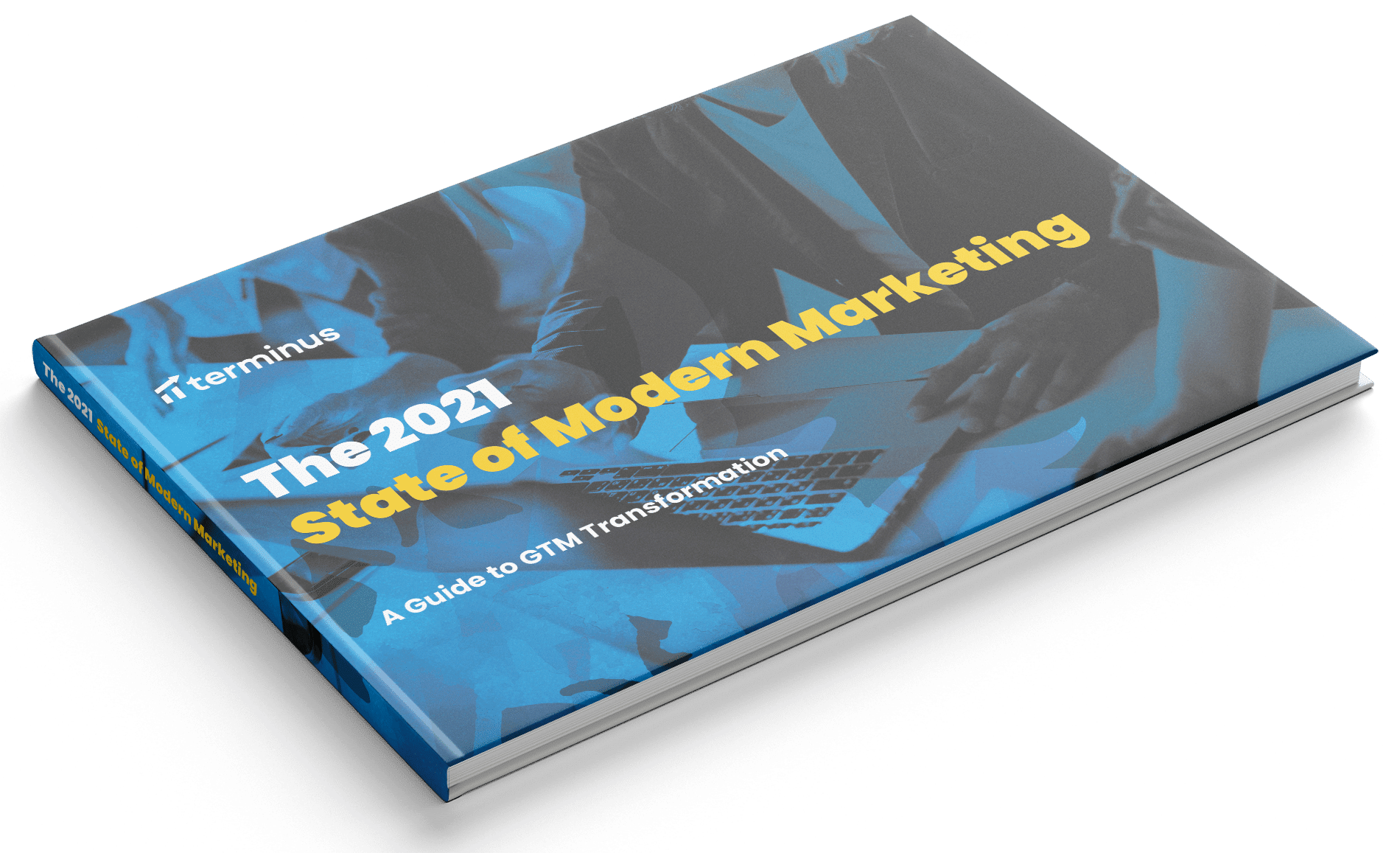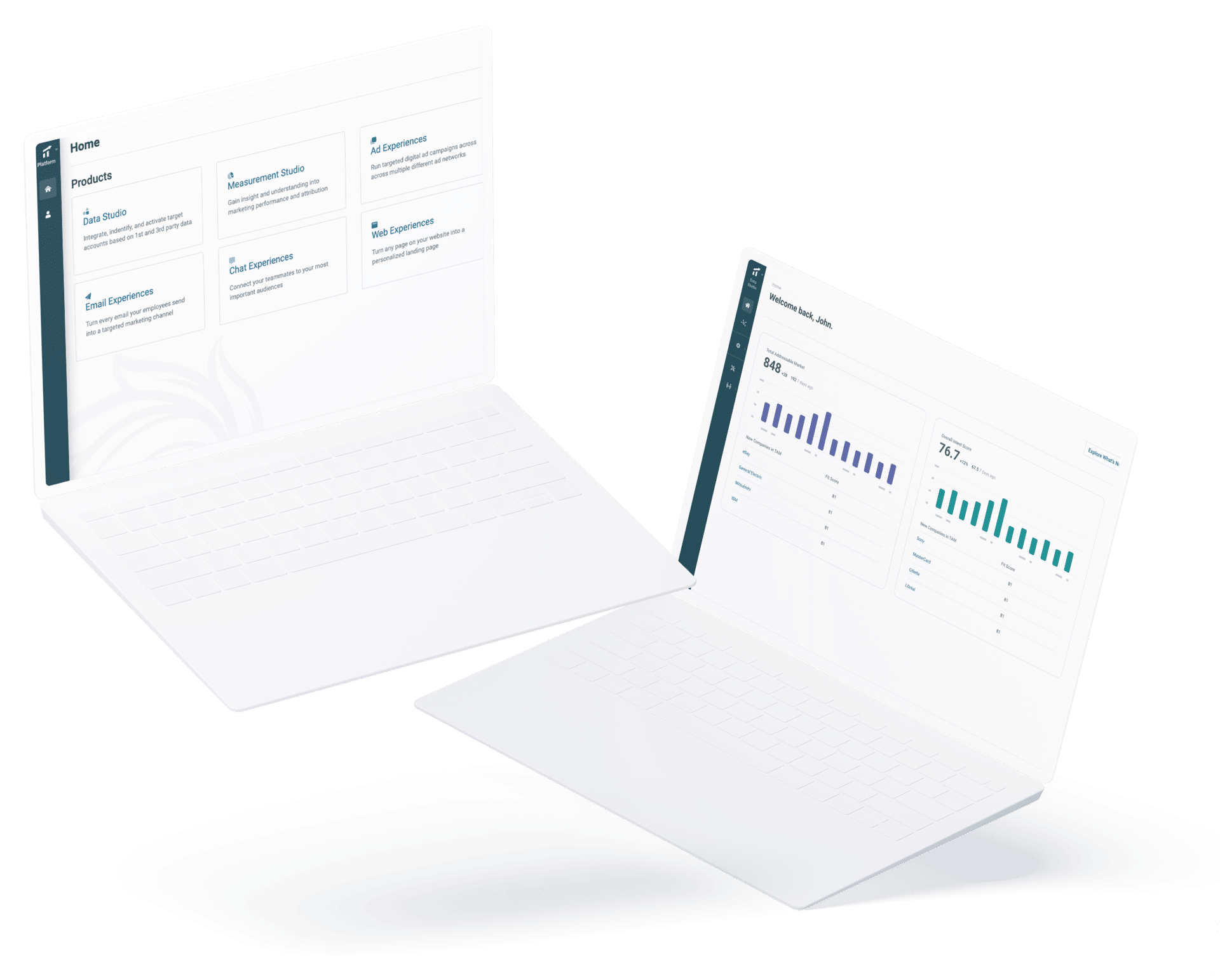Account Based Marketing 2021 Trends Report
The perfect resource that shows account based marketing 2021 trends, best practices, and strategies. Get full access to the report here or learn even more by seeing a Terminus demo.


Create, accelerate, and close more pipeline with Terminus
Terminus gives marketing teams the data they need to understand who their next customers are, all the channels they need to engage them, and customizable reporting and attribution to prove their impact.

A Forrester Total Economic Impact™ Study: Terminus ABM
Access it here
Terminus CEO, Tim Kopp’s Prediction on the Future of ABM
READ MORE
A Step-by-Step Template for Planning 2021 ABM Campaigns
DownloadAccount Based Marketing 2021
2021 — it’s a hard year to predict. Looking at ABM in 2020, it’s clear that COVID spurred a significant rush. We continue to see a shift from leads to revenue as the main marketing metric, and ABM is currently being used for customer retention as well as customer acquisition. ABM in 2021 is likely to continue to expand, for a variety of reasons.
First, account based marketing 2021 is going to be able to reach an increasingly remote customer. More people are making purchases online, but more companies are moving online, too. Account based marketing 2019 wasn’t nearly as critical as account based marketing 2020 — companies today have significant competition when it comes to developing an online connection with their clientele.
Account based marketing is going to be essential within competitive markets, as it can be used to create real, long-lasting relationships with customers. 2021 is likely to see customers continuing to purchase online, forge loyalties with online businesses, and connect to new and varied products. But because customers today are more fickle than ever before, and far less likely to become loyal to a brand, this loyalty can be difficult to nurture.
ABM solutions automate the process of developing brand identity and customer loyalty, making it easier than ever to connect with customers on a unique, customized level. Because of this, ABM is likely to become far more ubiquitous and advanced through 2021. With new, machine learning technologies, and a resurgence of interest, the ABM industry is going to see many advancements, changes, and increases in adoption.
Account Based Marketing Trends 2021
We know that account based marketing is going up. But what about account based marketing trends 2021? Exactly what ABM trends in 2021 are going to emerge?
First, lead generation continues to move towards obscurity. Since the beginning, an account-based strategy has been more about efficient revenue growth, by dedicating marketing resources only on the best-fit accounts. This is the 80/20 or Pareto principle; 20 percent of accounts will constitute 80 percent of the revenue. While lead generation is a natural component of any ABM program, it’s only a small part of it; B2B marketing trends 2020 showed this.
For ABM trends in 2020, there will be an increasing emphasis on account engagement and creating opportunities. More than lead generation, there will be lead nurturing, and more than lead acquisition, there will be customer retention. Rather than a “spray and pray” model,” this is a focused and targeted approach that helps organizations make the most of their resources. And organizations are increasingly going to want to do this, as their budgets will be spread thin.
2021 ABM trends are going to see a lot of organizations trying to do more with less. Not only is it a delicate time for many industries, but it’s also a time of some measure of uncertainty. The account based marketing strategy of these businesses is going to follow this cautious approach. Many companies are going to switch to ABM because it’s a far more effective, efficient, and affordable method of generating revenue. It ensures that companies are investing both their time and money into the leads that are going to yield them the most revenue, rather than trying to capture any leads at all.
Account Based Marketing Statistics 2021
Let’s take a look at some account based marketing statistics 2021, such as adoption statistics and performance statistics. More and more teams are adopting ABM. We saw this in account based marketing statistics 2019, account based marketing statistics 2020, and we will see this in the ABM stats 2021. ABM stats 2020 revealed that organizations are increasingly using ABM metrics such as pipeline generated, revenue generated, and meetings scheduled, rather than leads generated, which was common previously. B2B account based marketing is clearly changing and the numbers back it up.
A year ago, about 23 percent of respondents had no active ABM program. But in 2020, 94.2 percent have some form of ABM program. Thus, 2021 is likely to see near complete adoption of at least some ABM processes. 82 percent of respondents are looking at new business generation while only 42 percent are looking at lead generation; businesses are no longer just trying to generate meaningless leads but are really trying to connect with customers.
The number of mature programs are also growing. In 2018, only 9 percent of respondents said they had a mature ABM program. In 2019, that number was 17 percent. In 2020, it was 13 percent. But that percentage is somewhat misleading because of the number of people who entered into ABM as new developers. In 2021, we will likely see a smaller percentage of mature programs, but a much more significant amount of programs overall. And that also means that many people will be able to pull ahead of the pack in developing their ABM maturity.
Account Based Marketing 101
What is ABM? Let’s take a look at some account based marketing 101 lessons.
First: Account based marketing is very simple. It just sounds complex. Here are a few account based marketing examples and ABM campaign examples:
- Creating a custom eBook for decision-makers to download and then following up on the download with a customized email.
- Sending a packet through the mail that is tailored to individuals who visited a site and sent in a survey.
- Asking interested customers to customize and create a calendar that is then printed and sent to them, which then invites them to learn more.
- Emailing customers who have connected with the business before with a link to a customized landing page.
Account based marketing for dummies: It’s just customization. Account based marketing is about tracking clients through an account that collects tailored information about them, scoring them based on their prior interactions, and interacting with them in a unique and personalized way. Account based marketing case studies can go back to the very origins of marketing, when sales professionals would walk door to door and start to learn about each person.
The account based marketing framework can be built through an ABM platform or through an account based marketing plan template. You can also get an account based marketing playbook or look up an account based marketing PPT. Both ABM case studies and account based marketing success stories offer value in terms of what works best and what doesn’t work.
In the past, though, account based marketing could only be done one-on-one, and it was very difficult to do as a consequence. But now, there are some modern technologies that make it far easier. ABM platforms are able to automate much of the process of ABM, collecting information about customers, and connecting to customers easily. Account based marketing platforms also collect data regarding how successful campaigns are automatically, making it far easier to analyze what is and isn’t working for the organization, and easier to tailor campaigns to the organization and to its customers.
Account Based Marketing Customer Journey
What does an account based marketing customer journey look like from the customer’s perspective? Account based marketing tactics 2019 included live events, field marketing events, and physical merchandise — whatever could be done to breach digital presence and make the organization more real. But account based marketing tactics 2020 and 2021 are more about virtual events, personalized direct mail, and social media; people are engaging more with brands in the safety and comfort of their own home.
Understandably, account based advertising and account based marketing tactics need to adjust to the environment. They need to understand the journey that the customer is on, especially during difficult and unprecedented times. The way that the customer interacts with the brand will adjust based on their own situation and their environment, and the tactics that work with the customer will reflect the customer’s own journey.
When creating a buyer’s journey, account based marketing professionals need to think about the opportunities they have to extend their brand and to forge a real relationship with the customer. At every connection that the buyer makes with the business, the company should ask how that interaction could be better personalized and more meaningful. A traditional buyer’s journey is full of touchpoints which push the buyer further down the pipeline. This doesn’t change under ABM; rather, the ways the buyer is interacted with and pushed forward may change.
Account Based Marketing Market Size
Why is account based marketing taking off? What is the account based marketing market size? How much has the ABM market size really grown? And could it be a trend?
Let’s take a look at some of the major account based marketing companies: Terminus, Demandbase, 6sense, HubSpot, and Marketo. These account based marketing tools are experiencing significant increases in adoption, while account based marketing Hubspot and account based marketing Marketo stats are all showing tremendous ABM growth.
Customers today are fatigued and they are wary of advertising and paid messaging. At the same time, they still have needs and problems; problems that products and services can address. ABM represents a shift away from traditional, forceful sales techniques, and toward identifying the customers that are truly interested in a product or a service. Now that everyone has essentially a global market, it’s easier to find the customers that will sell products to themselves, rather than trying to tap an existing customer base.
ABM growth is due to the fact that ABM conversion rates are simply stronger. Account based marketing ROI is higher. And that’s because companies aren’t forcing products onto customers who aren’t interested. Companies are identifying and working with the customers who already want the product. ABM effectiveness is directly connected to finding the right customers and customizing marketing to them.
Many marketers are now building their account based marketing resume because of this. It’s a more competitive world, but it’s also one with more opportunities. Many people are no longer interested in traditional marketing techniques; they’re savvy to them and more liable to ignore them than engage. But these same people are looking for products and services and, with the right data, can be matched with the companies they are most interested in.
- ABM Platforms
- ABM Strategy
- ABM Software
- Account Based Marketing Software
- Account Based Marketing Strategy
- ABM Courses
- Account Based Marketing Class
- Account Based Marketing
- ABM Expert
- ABM 2020
- Account Based Marketing Checklist
- Account Based Marketing Platforms
- ABM Video
- ABM Solutions
- Account Based Marketing Basics
- Account Based Marketing Book
- ABM Marketing Conference
- ABM Conference
- Account Based Marketing Benchmarks
- Account Based Marketing Best Practices
- ABM at Scale
- Account Based Marketing Solutions
- ABM Tech Stack
- Account Based Marketing Tactics
- Ideal Customer Profile
- Account Based Marketing Customer Journey
- Account Based Marketing vs Inbound Marketing
- Enterprise ABM Solution
- Target Account Selling
- Key Account Marketing
- ABM Campaign
- Account Based Marketing Agency
- Account Based Marketing Pardot
- Account Based Marketing Tactics
- LinkedIn Account Based Marketing
- Account Based Experience (ABX)



